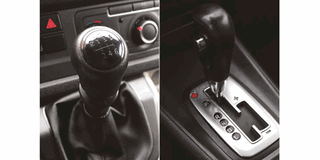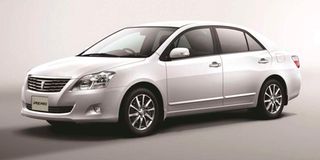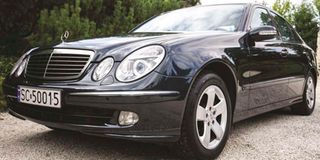Premium
Manual vs automatic cars – which is better?

A manual gearbox lever (left) and an automatic gearbox lever.
What you need to know:
- The debate on which is better between Manual vs automatic cars rages on.
- More and more of today’s cars will give you a fully automatic gearbox.
Which is better?
Less than a lifetime ago, you could count the number of automatic gearboxes in Kenya on the foot of a three-toed sloth. Today they are the increasingly dominant choice.
Therein lies one answer to the question of whether manual gears (stick shifts) or automatic gears are “better”.
But. Better at what? When? Where? For whom? Why?
Automatics are certainly not better at exercising your left leg. They are a bit heavier, a bit more expensive, structurally more complicated, absorb a bit more engine power and thus “might” use fractionally more fuel, and offer less self-determination (reduce your freedom of choice, sometimes either obstructing your genius…or preserving your dignity). Also you cannot push start or easily tow them.
Yet one of the last bastions of machismo is about to fall.
Going, going, gone are the totems and taboos of “real men”. Blokes not only eat quiche; they wear earrings, don foppish clothes, use skin creams, manicure their nails and wax their eyebrows, dab perfume behind their ears and sew ornaments in their hair.
And now, they even drive cars with automatic gearboxes! Yes, I kid you not, there are guys – many of them – ready to relinquish control of that manly stick and let a dandified machine not only decide what gear they should be in, but also make the changes for them.
What happened to the motoring mantra, reinforced with a triumphant fanfare of frapturous flatulence, that the only vehicle that should have only two pedals is a bicycle? What sort of a man is a man without a clutch? Are chaps not worried why even semi-automatic gear levers are called “floppy” paddles?
And apart from signalling the possible end of gender diversity as we know it, do automatic gearboxes not also reduce power and increase fuel consumption by at least one per cent?
Well yes, they do. Perhaps even two per cent. And they tend to reduce the amount of change-down assistance to braking, and can’t be push-started. But that is not going to save the good old four-on-the-floor, stick-shift, manual gearbox.
These days I find myself not only allowing the possibility of automatics (and owning one) but actually recommending them to readers who call or write in on the subject. The main reasons:
While changing gear manually takes next to no effort, and can even be quite fun on a fast climb up a twisty mountain pass or “tricking” traction to get through a muddy section where others are stuck, it is not easy and not fun, in a traffic jam.
And these days, what proportion of your motoring is an expression of freedom, pace and power; versus edging along in a stop-start queue, or grinding across a series of speed bumps (where the more non-sensory the whole driving process is the better. More on that subject later)?
Modern automatics
Next, far from reducing levels of control, automatics actually increase your precision in some low-speed manoeuvres – like edging along in a game park, and especially when reversing, especially if you are less than young with a neck that does not enjoy rotating through 180 degrees. With a manual gearstick, having to keep your left foot on the clutch while you ease backwards puts the entire burden of rearward vision on your neck only. With an automatic, where the left leg is redundant, you can swivel your bum on the seat and turn the whole top half of your body. Gives an entirely new meaning to the “wisdom of hindsight”.
Further, modern automatics - with kick-down and ease-off responses and the 2 and 1 restrictor settings - do allow the driver a very high degree of control if and when the mechanical brain isn’t making desirable decisions.
And there’s another even bigger reason to end the decades long debate on which is “better” - manual or automatic gearboxes? The answer is “neither”. Because modern technology can (and will) now give you “both”.
More and more of today’s cars and surely most of tomorrow’s will give you a fully automatic gearbox and, at the flick of a switch, let you change to a manual mode that you can operate with a single finger (and no clutch pedal).
So, real men, something to think about over your low-calorie spritzer and salad lunch after a bout in the gym to keep your left leg and arm in good shape.
Hello,
I want to buy a Toyota Corona Premio and need your advice about its fuel consumption, maintenance, durability and resale value. Can I get a brand new Toyota Corona Premio, and for how much? Which is the best transmission, manual or automatic?
Samuel M
Bear in mind that for any brand or model names there are probably dozens of current variants, even more over previous years of production.
Even apparently identical models can have different specifications in different years. And in different markets around the world, cars with the same model name can be different, and cars with different model names can be the same.
However brightly lit sales schpiels can be, marketing strategies are dark arts.
The Premio is a mid-range saloon in virtually every respect, with no exceptional strengths or weaknesses I am aware of. That includes fuel consumption, which anyway depends as much on your right foot as on any design factor.

Toyota Premio.
The Premio was designed for town and tarmac highways. I think production was discontinued last year, and replaced by the Prius Alpha. Up to then, nearly new or new ones cost Sh4 million or more. Popular models of established makes with respected agents are your best guide and positive indicators on maintenance, durability and resale issues.
This weekly clinic will try to offer readers the generic principles of things like fuel economy, durability, reliability, maintenance, performance, utility, comfort, ruggedness and resale value, and give insights on how to judge them, but will not generally offer subjective opinions about specific brands or models except in a distinct road test review.
Most main agents are not keen on objective or independent road tests. What they want the public to know they assign to their advertising agencies.
I will address your question on the choice between manual and automatic gearboxes separately. That advice will not focus on makes and models, it will hinge on the technical pros and cons of the two systems, and match them to the differing motoring patterns and preferences of car owners.
Of rugs and the rugged
Why does the underneath of Mercedes E-Series (200,250 and 300) often attract rugs? I have seen quite a number dragging nylon/rugs below the chassis. Isn’t a Renault Kwid one of the most under-rated cars? Tough as nails, known for ruggedness. Think the Renault Duster.
Ochieng
I have not noticed this phenomenon between Mercedes floorpans and the road, and can only guess that either the owners of such smart cars park them in their living rooms and they occasionally snag one of the carpets on the way to and from the front door, or what you descriptively call a “rug” or “nylon” is actually some kind of insulation material attached to the floorpan (to counteract either heat or noise) which has come loose.

Mercedes-Benz E-Class
Also possible, but less likely, is that it is fibreglass matting from which the stiffening resin element has been scrubbed off by the top of speed bumps.
On the Renault Kwid, I wonder what makes you think it was or is “under-rated”. It came on to the world market at under $4,000 and was one of the best-sellers in the revolutionary cadre of super-cheap mini cars during its six-year production span (which ended recently).

Renault 4L
Renault’s pioneering inventions are a legend of motoring history and small Renaults have an especially remarkable track record. Ancient Kenyans will remember best the Renault Quatre L (4L) which was nicknamed here the “Roho”…perhaps because it kept going (in its bouncy way) even when its bodywork was falling apart.
Different... but the same
I am planning to buy my first car; a Subaru Levorg. I’d really appreciate your perspective on the 1.6GT vs 1.6GT-S in terms of maintenance and performance. Also, please assess the Eyesight/Subaru Rear Vehicle Detection system.
Wambui M.
Same make, same model, same engine size, same performance. Although an “S” designation usually stands for “Sport”, in this case the difference is in the Ssuspension Sstiffness (Ssic). The S has harder (and adjustable) shock-absorbers, and about 40 kilos of extra stabliliser kit. The ride is harsher but the handling steadier when driven hard.
The Levorg is basically a replacement for the Legacy, though the platforms of many of Subaru’s models are so rationally shared that this is more a declaration of the Levorg’s target market than homage to any unique aspect of its predecessor.
Subaru model names are sometimes a cause for wonder. The Tribeca, for example, was derived from TRIangle BElow CAnal street (an area of New York notorious for its grotty roads, with the supposition that the Tribeca would be rather good at handling them). The Levorg comes from LEgacy reVOlution touRinG. Japanese logic, French sounding, the ring of a 1950s Hollywood stage name, and English wording. Go figure.

Subaru Levorg.
“Eyesight” is a technology that watches a driver’s face and sounds an alarm if the eyes indicate distraction or sleepiness. Presumably the system would short-circuit in the event of catatonia or thyroid gland malfunction that makes eyes “poppy”. It has recently been incorporated into some of the increasingly common detection systems that suround a vehicle with cameras and/or sensors, beep if a collision is imminent, and can provide a rear-view TV picture on the dashboard when reversing. They are easier to use if you are dyslexic.
Next, there is technology that will keep an eye on the entire passenger cabin. Older readers may remember a song: “Keep your mind on your driving keep your hands on the wheel, keep your sleepy eyes on the road ahead, we’re having fun, sitting in the back seat akissing and ahugging with Fred”.
Do you have motoring questions? Email [email protected]





